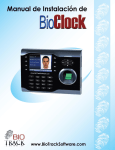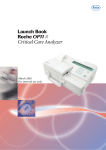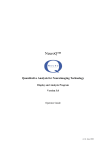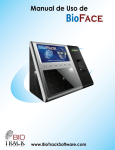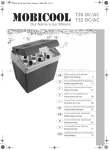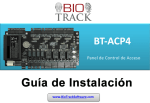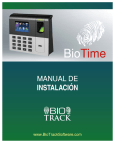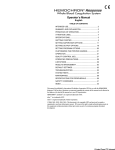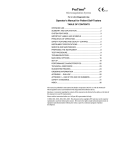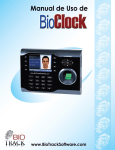Download 11. Geriatric Patients and Point of Care Collection and Testing
Transcript
11. A. Geriatric Patients and Point of Care Collection and Testing Geriatric Patients 1. The elderly account for almost 15% of the total population, but use over 30% of the healthcare services in the nation. It is estimated that in the next 25 years, 20% of the U.S. population will be elderly. 2. The normal aging process causes a variety of physical and emotional issues that can be difficult for both the geriatric patient and healthcare worker. 3. Some of the special interpersonal skills needed when dealing with this age group include: 4. a. Treat patients with the upmost respect and dignity b. Establish eye contact c. Be sensitive to their needs and have patience d. Smile Some common conditions experienced by this group a. Hearing loss – speak slowly and clearly; patient may turn so they can hear you in their “good” ear. b. Failing eyesight – may need assistance with being guided to a chair c. Loss of taste, smell and feeling – loss of appetite may lead to malnourishment and dehydration d. Memory loss – they may not remember when they last ate, so you may not be sure if a specimen is truly fasting e. Tissues become thinner – veins become more fragile and are not as well anchored; more likely to roll; avoid tight tourniquet applications that can cause bruising, adhesive bandaids which may remove skin. f. Muscles become smaller – angle of needle may need to be more shallow; they may not be able to make a fist due to muscle weakness g. Increased susceptibility to hypothermia – may make them feel cold, so warming of site prior to venipuncture or finger stick may be necessary h. Emotional problems – may be depressed or angry at life in general due to loss of family, friends, career, abilities, independence Unit 11—Geriatric Patients and Point of Care Collection and Testing Page 1 5. B. Special considerations for collections in a residence, assisted living facility, or nursing home a. Have extra supplies and equipment, including sharps and biohazard containers b. Take special care in identifying the patient c. Place patient in a comfortable, reclining position d. Locate the nearest location with sink and towels e. Use hand disinfectant prior to putting on gloves and starting procedure f. Make sure puncture site has stopped bleeding before you leave g. Carefully inspect area after procedure; remove all trash and supplies h. Carefully label samples and put in leak proof container or bag for transport i. Carefully document delays in delivery of specimens to laboratory Point-of-Care Collection and Testing 1. Laboratory testing and results delivery have expanded beyond the laboratory and many terms are utilized to describe testing done outside the traditional laboratory: a. Point-of-care testing (POCT) most common term used. b. Decentralized laboratory testing c. On-site testing d. Alternate-site testing e. Near-patient testing f. Patient-focused testing g. Bedside testing 2. Other healthcare providers are increasingly performing point-of-care testing 3. Many considerations are common to all Point-of-Care testing procedures a. Carefully read the user manual and package inserts to understand proper operation of equipment and the use of controls, standards, and supplies b. Any healthcare worker performing Point-of-Care testing must have proper training on the specific equipment being used and the correct specimen collection procedure c. A rigid daily quality control program must be followed. Failure to follow daily quality control can have serious medical consequences for patients. Unit 11—Geriatric Patients and Point of Care Collection and Testing Page 2 d. C. Proper documentation is vital and includes: 1) Date and time of use 2) Lot number and expiration date of reagents, test strips and controls 3) Proper recording of controls and patient results 4) Name or initials of individuals performing test and recording results 5) Documentation must also include regular scheduled maintenance, cleaning, and battery replacement as well as malfunctions and repairs 6) Controls must have the mean and standard deviation calculated and plotted 7) Instruments with automatic or “electronic quality control” that test the internal circuits must also have this testing recorded Glucose Monitoring 1. Most widely used point-of-care test 2. Used to determine blood glucose levels to determine appropriate treatment for patients with diabetes mellitus. 3. Small glucose measuring devices have become commonplace in home, nursing home, ER, ICU and hospital bedside testing. 4. Most commonly uses capillary puncture to obtain a whole blood specimen which is applied to a special reagent pad which changes color in the presence of glucose; the color produced is directly proportional to the amount of glucose in the patient’s blood. 5. Most popular method is the electrochemical biosensor: 6. a. Blood applied to strip in the instrument. b. Plasma from the whole-blood sample diffuses into and dissolves the reagent layer which contains glucose oxidase or glucose dehydrogenase and electrodes. c. Glucose is catalyzed to form gluconic acid by the glucose dehydrogenase or glucose oxidate reagent. d. The electrons produced during the reaction forms a current. e. The current is calibrated to measure the glucose concentration in the whole blood sample. f. Helps diabetics monitor blood glucose to adjust insulin level. Proper training of personnel and quality control of the instrument is critical. a. Careful adherence to manufacturer’s instructions is critical. Unit 11—Geriatric Patients and Point of Care Collection and Testing Page 3 D. Daily quality control of the instrument with specific instructions on how to deal with malfunctioning equipment must be documented. c. Careful recording of all results and documentation of problems and corrective action. Hematocrits, Hemaglobin, and Other Hematology Parameters 1. 2. 3. E. b. The hematocrit represents the volume of whole blood which is RBCs and is expressed as a percentage. a. Hematocrits are used to aid in the diagnosis of anemia. b. For accurate results, do not squeeze the finger too hard. Hemoglobin is the substance in the red blood cell which transports oxygen to the tissue; measurement of hemoglobin is used to aid in the diagnosis of anemia. a. The American Medical Association (AMA) has determined that the hemoglobin is more accurate than the hematocrit. b. The HemoCue B-Hemoglobin and Hemopointe H2 Systems are POCT hemoglobin analyzers which use venous, capillary or arterial whole blood placed in a microcuvette and inserted into the instrument to provide a patient’s hemoglobin value. Automated cell counting machines are available to perform platelet count, hemoglobin, hematocrit, WBC count and RBC count. Blood Coagulation Monitoring 1. Similar to glucose monitoring, blood coagulation monitoring through POCT can provide immediate results that can be used in controlling bleeding or clotting disorders in patients. 2. Examples of this type of instrumentation include: a. CIBA Corning Biotrack 512 coagulation monitor b. Roche Diagnostics Corp handheld c. CoaguChek S System d. International Technidyne Corp (ITC) e. ProTime Microcoagulation System f. Actalyke Activated Clotting Time Test (ACT) System g. Hemochron Jr. Instrument h. Rapidpoint Coag analyzer Unit 11—Geriatric Patients and Point of Care Collection and Testing Page 4 3. G. H. INRatio Meter j. All of these instruments can be used with only a few drops of blood and provide results within minutes. Proper training in use, preventive maintenance and QC is critical. Cholesterol Screening 1. Provides diagnostic tool to identify patients at risk of heart disease. 2. Very popular for health fairs. 3. Some instruments are moderate in size and portable; drop of whole blood is placed on a special strip, inserted into the machine and a result is displayed. 4. Another type of screening procedure (AccuMeter) uses whole blood and a visual evaluation of the colored bar height of the cholesterol reaction. 5. The Cholestech LDX System can perform a lipid profile including total cholesterol, HDL cholesterol, LDL cholesterol and triglycerides in 5 minutes with just 35 microliters of whole blood. Blood Gas and Electrolyte Analysis 1. I. i. Blood gas analysis involves measurement of the partial pressure of oxygen (PO2), the patient’s carbon dioxide (PCO2), and pH. a. PO2 and PCO2 are analyzed when a patient has a heart or lung disorder. b. Blood pH determines whether the blood is too acidic or too alkaline. 2. The I-STAT instrument is a very popular POCT device which can monitor blood gases and electrolyte levels – sodium, potassium, chloride and bicarbonate levels. 3. These instruments require preventive maintenance and quality control similar to glucose monitoring instruments. a. Because more than one analyte is measured, the operation, QC and maintenance is more complex. b. It is critical that only well trained individuals use the instruments. Future Trends 1. More POCT procedures are evolving at a rapid rate. 2. Phlebotomists, nurses, patient care technicians and other individuals providing healthcare will be involved in using these new techniques. 3. It is critical that proper training on any POCT instrument include: Unit 11—Geriatric Patients and Point of Care Collection and Testing Page 5 a. Proper sample collection procedure b. Preventive maintenance c. Quality control d. Calibration requirements e. Troubleshooting f. Infection control g. Ethical and legal implications of the testing h. Record keeping Unit 11—Geriatric Patients and Point of Care Collection and Testing Page 6







